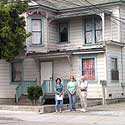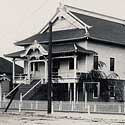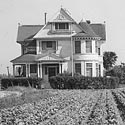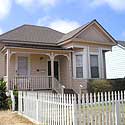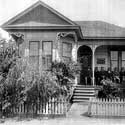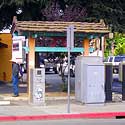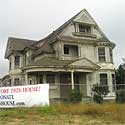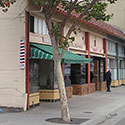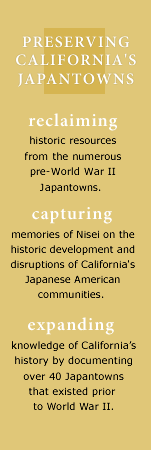 |
WatsonvilleAs in much of rural California, farm work provided entry into the labor market for early Japanese immigrants in Watsonville as early as 1892. Five years later Sakuso Kimura, an immigrant from Osaka, formed the first labor group and mutual assistance organization. Strawberry and sugar beet farming soon became the dominant local crop tended by Japanese, who formed a strawberry cooperative, Naturipe, in 1910, to distribute their produce. By 1940, Watsonville’s Nihonmachi was centered along Main and Union Streets with commercial and professional services catering to local Nikkei and migrant farm workers passing through the area. A Japanese language school, Toyo Hall (a community center), and judo and kendo dojos were located next to a much used baseball field. They reflected the varied needs and interests of Watsonville’s Japanese American residents. ›› CLICK TO ENLARGE.
PROFILES
| ||||

Jill Shiraki, Donna Graves and Mas Hashimoto in front of the Hashimoto home on Union Street. Mas Hashimoto led us on a tour of Watsonville’s Japantown. During the 1920-30s, the Hashimotos ran a small udon shop and sake brewery from the first floor of their house, and rented the second story to Dr. Frank Ito, a dentist. Previously, the house sat one block north as a one-story structure, next door to the Buddhist Church, and served as headquarters for the local Japanese Association.

The tori gate of Watsonville's former Buddhist Temple, now hard to see among the street furnishings of a corner parking lot.

This image shows the Hashimoto house one block north on Union Street, when it served as headquarters for the local Japanese Association.

Watsonville's Buddhist Temple was constructed in 1906 at the corner of Union and Bridge Streets. All that remains of the historic building is a tori gate. [See adjacent photo.] Panoramic views of the Buddhist Temple with the Japanese Association building next door can be found at the Japanese American National Museum website.

As it stands today, the Redman-Hirahara House is the focus of an ambitious project to preserve, interpret and reuse this site as a location to acknowledge the Pajaro Valley’s rich agricultural legacy. For more information, visit the Redman House site.

Many Nikkei ran small businesses out of their place of residence. This house held the Matsuoka Maternity home, where Issei women could deliver their children under the skilled care of Mrs. Matsuoka (mother to famed cartoonist Jack Matsuoka).

Built in 1897 for prosperous farmer James Redman, this house and the farmlands around it were purchased by the Hirahara family in the 1930s, who resided here until the late 1980s. The Hiraharas managed to maintain ownership of the farm during WWII interment. Photo courtesy of Bancroft Library.

Tokuzo Oda opened a barbershop and bathhouse in 1912 on S. Main Street in a two-story Victorian building. The heart of Watsonville's Nihonmachi held Nikkei-run tofu shops, boarding houses, laundries and grocery stores interspersed with Chinese businesses. Immigrant farm workers from Japan and the Philippines patronized Oda's establishment until the family was interned in 1942. Tokuzo Oda reopened his shop in this building up Main street upon his return in 1945. Fred Oda joined his father in 1949 and ran the business for almost sixty years. Oda's Barber shop closed in 2007.
